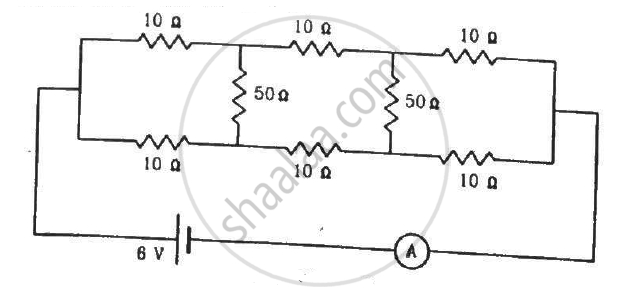Advertisements
Advertisements
Question
A voltmeter coil has resistance 50.0 Ω and a resistor of 1.15 kΩ is connected in series. It can read potential differences up to 12 volts. If this same coil is used to construct an ammeter that can measure currents up to 2.0 A, what should be the resistance of the shunt used?
Solution
The effective resistance for the voltmeter,
Reff = (1150 + 50) Ω = 1200 Ω
The maximum current ig through the coil for maximum deflection of 12 V,
\[i_g = \left( \frac{12}{1200} \right) A = 0 . 01 A\]
Let R be the resistance of the shunt used for ammeter.
Resistance of the coil, g = 50 Ω
Maximum deflection current, i, through the ammeter = 2 A
Since R and g are connected in parallel,
\[g \times i_g = R \times \left( i - i_g \right)\]
\[ \Rightarrow R = \frac{g \times i_g}{\left( i - i_g \right)}\]
\[ \Rightarrow R = \frac{50 \times 0 . 01}{2 - 0 . 01} = 0 . 251 \Omega\]
APPEARS IN
RELATED QUESTIONS
If the combination is connected to a battery of emf 12 V and negligible internal resistance, obtain the potential drop across each resistor.
Three resistors 2 Ω, 4 Ω and 5 Ω are combined in parallel. What is the total resistance of the combination?
Two electric bulbs P and Q have their resistances in the ratio of 1 : 2. They are connected in series across a battery. Find the ratio of the power dissipation in these bulbs
Two heating elements of resistances R1 and R2 when operated at a constant supply of voltage, V, consume powers P1 and P2 respectively. Deduce the expressions for the power of their combination whey they are, in turn, connected in (i) series and (ii) parallel across the same voltage supply.
Which of the following quantities does not change when a resistor connected to a battery is heated due to the current?
Find the current measured by the ammeter in the circuit shown in the figure.

An ammeter together with an unknown resistance in series is connected across two identical batteries each of emf 1.5 V. When the batteries are connected in series, the galvanometer records a current of 1A and when the batteries are in parallel, the current is 0.6A. Then the internal resistance of the battery is ______.
Combine three resistors 5 Q, 4.5 Q and 3 Q in such a way that the total resistance of this combination is maximum ______.
An electric current is passed through a circuit containing two wires of the same material, connected in parallel. If the lengths and radii of the wires are in the ratio of 3:2 and 2:3, then the ratio of the current passing through the wire will be ____________.
Assertion (A): To increase the range of an ammeter, we must connect a suitable high resistance in series to it.
Reason (R): The ammeter with increased range should have high resistance.
Select the most appropriate answer from the options given below:
How many times will the resistance of an identical conductor be increase, if the parallel resistance be change to series one?
A condenses having a capacity 2.0 µF is charged to 200 V and the plates of the capacitor are connected to a resistance wire. The heat produce in it will be:-
The equivalent resistance of resistors connected in series is always ______
Let there be n resistors R1............Rn with Rmax = max (R1......... Rn) and Rmin = min {R1..... Rn}. Show that when they are connected in parallel, the resultant resistance RP < R min and when they are connected in series, the resultant resistance RS > Rmax. Interpret the result physically.
A wire of uniform cross-section and resistance 4 ohms is bent in the shape of square ABCD. Point A is connected to point P on DC by a wire AP of resistance 1 ohm. When a potential difference is applied between A and C, the points B and P are seen to be at the same potential. What is the resistance of the part DP?

